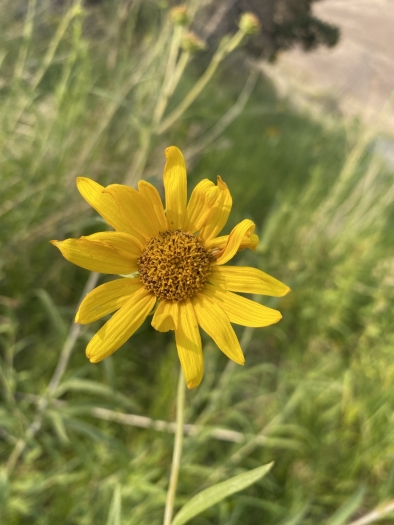Nuttall’s Sunflower
(Helianthus nuttallii)
Nuttall’s Sunflower (Helianthus nuttallii)
/
/

© Matt Berger
CC BY 4.0
Image By:
© Matt Berger
Recorded By:
Copyright:
CC BY 4.0
Copyright Notice:
Photo by: © Matt Berger | License Type: CC BY 4.0 | License URL: http://creativecommons.org/licenses/by/4.0/ | Uploader: sheriff_woody_pct | Publisher: iNaturalist |























Estimated Native Range
Summary
Helianthus nuttallii, commonly known as Nuttall’s Sunflower, is a herbaceous perennial native to a variety of habitats including moist meadows, riverbanks, and open woodlands across northern, central, and western North America, from Newfoundland to British Columbia, south to Missouri, New Mexico, and California. It can grow to a height of 20-157 inches (50-400 cm), with narrow lanceolate leaves that are 3-8 inches (7.5-20 cm) long. The plant is characterized by its showy yellow flowerheads, which are approximately 4 inches (10 cm) in diameter, featuring 10-20 ray florets surrounding at least 60 disc florets, blooming from late summer to early fall.
Nuttall’s Sunflower is valued for its tall, striking flowers that attract pollinators such as bees and butterflies, making it a beneficial addition to wildlife gardens. It is also used for naturalistic plantings and as a cut flower due to its showy blooms. This sunflower thrives in full sun and requires well-drained soils, though it can tolerate a range of soil types. It is relatively low maintenance but may need support due to its height. While generally disease-resistant, it can be susceptible to rust and mildew in humid conditions. Nuttall’s Sunflower is not known for being invasive but can spread through rhizomes and self-seeding if conditions are favorable.CC BY-SA 4.0
Nuttall’s Sunflower is valued for its tall, striking flowers that attract pollinators such as bees and butterflies, making it a beneficial addition to wildlife gardens. It is also used for naturalistic plantings and as a cut flower due to its showy blooms. This sunflower thrives in full sun and requires well-drained soils, though it can tolerate a range of soil types. It is relatively low maintenance but may need support due to its height. While generally disease-resistant, it can be susceptible to rust and mildew in humid conditions. Nuttall’s Sunflower is not known for being invasive but can spread through rhizomes and self-seeding if conditions are favorable.CC BY-SA 4.0
Plant Description
- Plant Type: Herb
- Height: 3-9 feet
- Width: 2-3 feet
- Growth Rate: Moderate
- Flower Color: Yellow
- Flowering Season: Summer, Fall
- Leaf Retention: Deciduous
Growth Requirements
- Sun: Full Sun, Part Shade
- Water: Medium, High
- Drainage: Medium, Slow
Common Uses
Bee Garden, Bird Garden, Border Plant, Butterfly Garden, Deer Resistant, Erosion Control, Low Maintenance, Water Garden
Natural Habitat
Moist meadows, riverbanks, and open woodlands
Other Names
Common Names: Hairy Sunflower, Clustered Sunflower, Common Tall Sunflower, White-rayed Sunflower
Scientific Names: , Helianthus nuttallii, Helianthus nuttallii f. nuttallii, Helianthus nuttallii var. nuttallii,
GBIF Accepted Name: